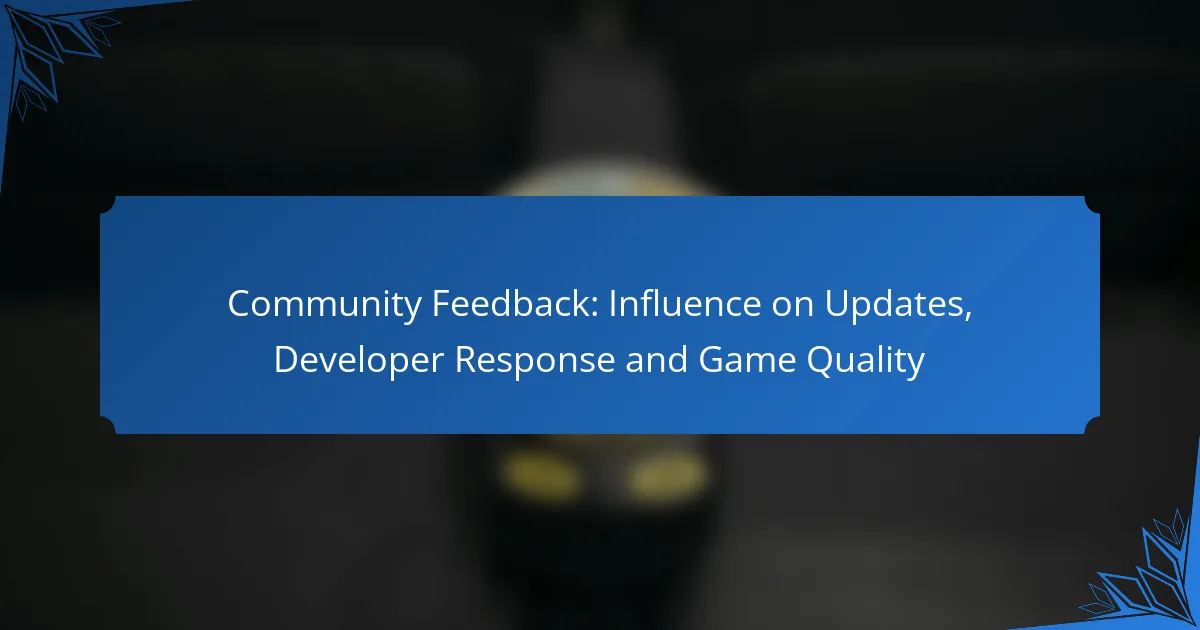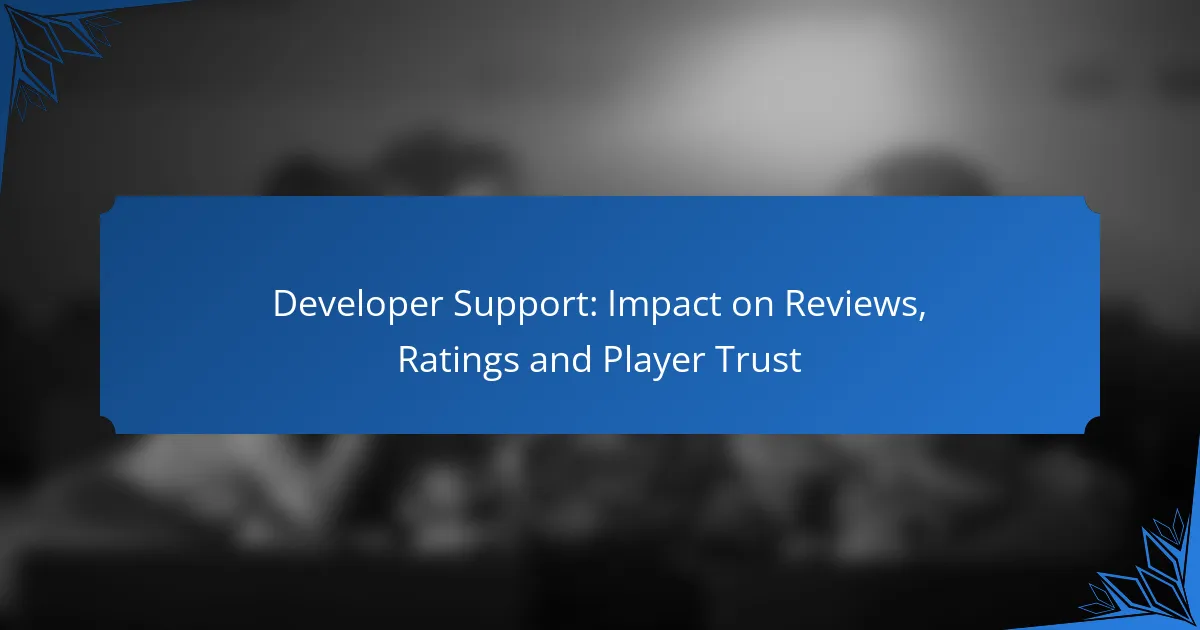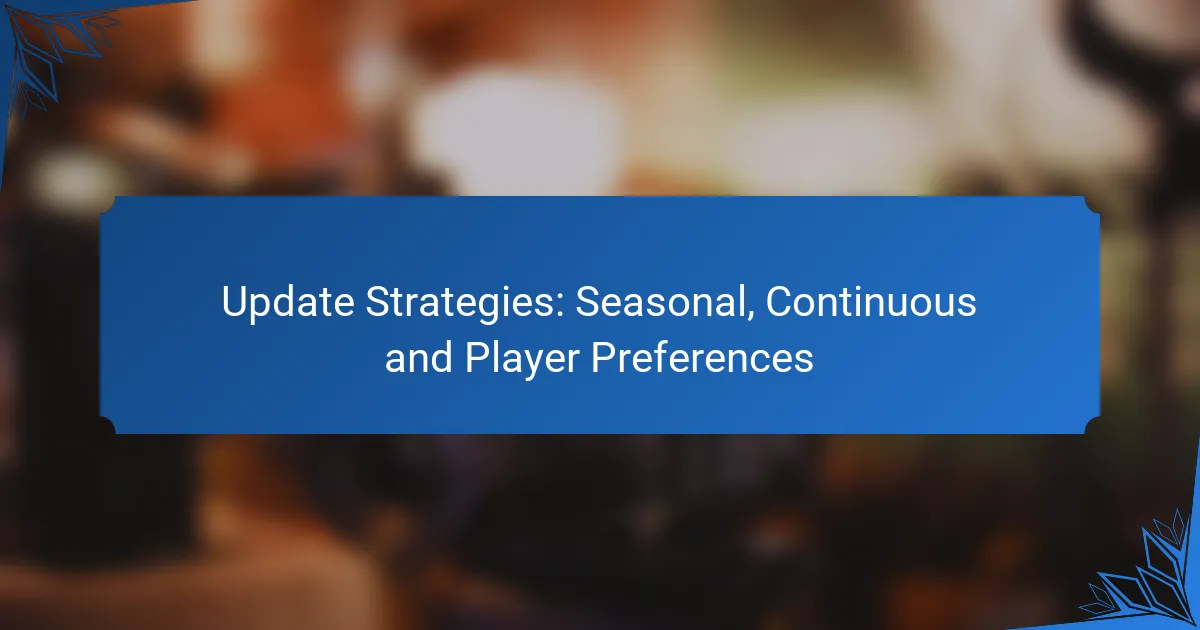Frequent updates play a crucial role in enhancing player satisfaction by ensuring that the gaming experience remains fresh and engaging. By regularly introducing new content, addressing player concerns, and incorporating community feedback, developers can foster a dynamic environment that not only boosts engagement but also improves player retention rates.

How do frequent updates enhance player satisfaction?
Frequent updates significantly boost player satisfaction by keeping the gaming experience fresh and engaging. Regular content additions and improvements can address player concerns, introduce new features, and maintain interest over time.
Improved gameplay experience
Frequent updates enhance the gameplay experience by introducing new content, fixing bugs, and optimizing performance. Players appreciate when developers actively work to refine the game, leading to smoother mechanics and more enjoyable interactions.
For example, adding new levels, characters, or game modes can revitalize interest and encourage players to return. Regularly scheduled updates can also help maintain a sense of community as players anticipate new features together.
Increased player feedback incorporation
Regular updates allow developers to incorporate player feedback more effectively. When players see their suggestions implemented, it fosters a sense of ownership and connection to the game.
Surveys, forums, and social media channels can be utilized to gather player opinions. By addressing common concerns or requests in updates, developers can enhance player loyalty and satisfaction.
Enhanced game balance
Frequent updates contribute to better game balance by allowing developers to adjust gameplay elements based on player performance and feedback. This ongoing refinement helps ensure that no single strategy or character dominates the game.
For instance, if a particular character is consistently winning matches, developers can tweak their abilities in an update to create a more level playing field. This responsiveness keeps the game competitive and engaging for all players.

What strategies boost player engagement through updates?
To enhance player engagement through updates, developers should focus on delivering regular content, creating seasonal events, and incorporating community feedback. These strategies foster a dynamic gaming environment that keeps players returning and invested in the game.
Regular content additions
Regular content additions, such as new levels, characters, or game modes, are essential for maintaining player interest. By introducing fresh elements consistently, developers can keep the gameplay experience exciting and encourage players to explore new features. Aim for updates every few weeks to sustain engagement.
Consider implementing a content calendar to plan these additions strategically. This helps in managing player expectations and ensures that updates align with player interests and seasonal trends.
Seasonal events and challenges
Seasonal events and challenges create a sense of urgency and exclusivity, motivating players to participate. These events can include limited-time quests, themed rewards, or special competitions that resonate with holidays or significant dates. Implementing such events a few times a year can significantly boost player activity.
Ensure that rewards for participating in these events are appealing and unique to encourage participation. For example, offering exclusive skins or in-game currency can entice players to engage more deeply during these periods.
Community-driven updates
Community-driven updates allow players to feel valued and heard, which can enhance their loyalty to the game. Gathering feedback through surveys, forums, or social media can provide insights into what players want to see improved or added. Regularly incorporating this feedback into updates shows players that their opinions matter.
Consider establishing a beta testing group from your community to trial new features before full implementation. This not only helps in refining updates but also builds a stronger connection with your player base, fostering a sense of ownership and involvement in the game’s evolution.

How can updates improve player retention rates?
Frequent updates can significantly enhance player retention rates by addressing player needs, enhancing engagement, and creating a dynamic gaming environment. Regularly introducing new content and features keeps players invested and encourages them to return to the game.
Addressing player concerns promptly
Timely updates that respond to player feedback can greatly improve satisfaction and loyalty. When players see that their concerns are acknowledged and resolved quickly, they feel valued and are more likely to continue playing.
For instance, if players report bugs or balance issues, addressing these within a week can prevent frustration and reduce churn. Establishing a feedback loop where players can voice their concerns and see actionable results fosters a positive community atmosphere.
Implementing loyalty rewards
Loyalty rewards are an effective way to incentivize continued engagement. By offering players bonuses for regular play, such as exclusive items or in-game currency, developers can encourage longer play sessions and repeat logins.
Consider implementing tiered rewards that increase in value with the player’s time spent in the game. This not only motivates players to return but also enhances their overall experience by making them feel recognized for their commitment.
Creating a sense of progression
Updates that introduce new levels, challenges, or storylines can create a compelling sense of progression. Players are more likely to stay engaged when they feel they are advancing and achieving goals within the game.
Incorporating seasonal events or limited-time challenges can also enhance this feeling of progression. For example, offering special quests that unlock unique rewards encourages players to log in regularly to complete them, thus boosting retention rates.

What metrics measure player satisfaction with updates?
Player satisfaction with updates can be measured through various metrics that reflect their experiences and engagement levels. Key indicators include player feedback surveys, engagement analytics, and retention statistics, each providing insights into how updates impact overall satisfaction.
Player feedback surveys
Player feedback surveys are direct tools for gauging satisfaction levels regarding updates. These surveys can include questions about specific features, gameplay changes, and overall enjoyment, allowing players to express their opinions and experiences. Aim for a response rate of at least 10-15% to ensure a representative sample.
To enhance the effectiveness of surveys, consider using a mix of quantitative questions (like rating scales) and qualitative open-ended questions. This combination can provide both measurable data and detailed insights into player sentiments.
Engagement analytics
Engagement analytics track player interactions with the game following updates. Metrics such as daily active users (DAU), session length, and in-game purchases can indicate how updates influence player behavior. A noticeable increase in DAU or session length after an update typically signals positive player reception.
Utilize tools like Google Analytics or in-game telemetry to gather data on player engagement. Monitoring these metrics over time can help identify trends and inform future updates, ensuring they align with player preferences.
Retention statistics
Retention statistics measure how well a game keeps players returning after updates. Common metrics include day 1, day 7, and day 30 retention rates, which show the percentage of players who return to the game after one day, one week, and one month, respectively. A drop in these rates post-update may indicate dissatisfaction.
To improve retention, analyze the reasons behind player drop-off through exit surveys or in-game prompts. Implementing changes based on this feedback can help maintain a loyal player base and enhance overall satisfaction with future updates.

How do different game genres utilize updates for player satisfaction?
Different game genres employ updates in unique ways to enhance player satisfaction. Action games often rely on frequent patches to fix bugs and balance gameplay, while MMORPGs introduce expansion packs to keep players engaged with new content. Mobile games typically focus on regular content drops to maintain interest and encourage retention.
Action games with frequent patches
Action games benefit from regular patches that address gameplay balance, fix bugs, and introduce new features. These updates can occur weekly or bi-weekly, depending on the game’s community feedback and the developers’ resources. For example, a popular shooter may release patches to adjust weapon performance based on player usage statistics.
Maintaining a responsive update schedule helps retain players and fosters a sense of community. Developers should prioritize transparency about changes and involve players in discussions to enhance satisfaction.
MMORPGs and expansion packs
MMORPGs often utilize expansion packs as significant updates that introduce new storylines, characters, and gameplay mechanics. These expansions are typically released annually or bi-annually and can significantly boost player engagement. For instance, a fantasy MMORPG might launch an expansion that adds a new continent and quests, enticing players to return.
Regular smaller updates between expansions can help maintain interest by fixing bugs and introducing seasonal events. Developers should ensure that expansions provide enough value to justify their cost, as players expect substantial content for their investment.
Mobile games with regular content drops
Mobile games frequently implement regular content drops to keep players engaged and encourage daily logins. These updates can include new levels, characters, or limited-time events, often occurring every few weeks. For example, a mobile puzzle game might introduce a new theme or challenge every month to retain its player base.
Incorporating player feedback into these updates is crucial for maintaining satisfaction. Developers should consider offering incentives, such as in-game currency or exclusive items, to reward players for participating in new content, thus enhancing retention rates.

What are the challenges of implementing frequent updates?
Implementing frequent updates can lead to several challenges, including resource allocation, maintaining quality, and managing player expectations. These factors can significantly impact player satisfaction and retention if not addressed effectively.
Resource allocation issues
Frequent updates require careful resource allocation, as teams must balance development time with other operational needs. This often means prioritizing certain features or fixes over others, which can lead to dissatisfaction among players who feel their concerns are overlooked.
To manage resources effectively, consider adopting agile methodologies that allow for iterative development and regular feedback loops. This approach enables teams to respond quickly to player feedback and adjust priorities as needed.
Additionally, ensure that your team has the right mix of skills and tools. Investing in automation for testing and deployment can free up valuable developer time, allowing for more frequent and higher-quality updates.



